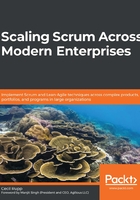
Summary
In this chapter, you have learned the following about Scrum, as well as its relevance to agile practices in terms of development and to support operational business functions:
The term Scrum comes from a sports metaphor related to Scrum. We also looked at why a team-oriented concept improves software and systems development and delivery.
The importance of executive leadership and support for long-term success and enterprise-wide adoptions.
How Scrum's empirical process control theory helps teams work through complex adaptive problems through experimentation and observation. We also looked at the importance of its three pillars: transparency, inspection, and adaption.
Scrum has a product-oriented focus on development, not a project-oriented focus. We looked at how that helps put the focus squarely on adding customer-centric value.
You also learned about the essential elements of Scrum so that you can include its rules, roles, responsibilities, artifacts, and events.
Finally, you learned that Scrum is Scrum and that any attempts to modify the basic approach may have unintended and unfortunate consequences.
In the next chapter, you will learn how to apply Scrum's events to guide the Scrum Team's work across an iterative development cycle. You will get a better understanding of the responsibilities of each of the roles defined in Scrum across a Sprint. You will also learn how the artifacts of Scrum support the three pillars of empiricism: transparency, inspection, and adaption.